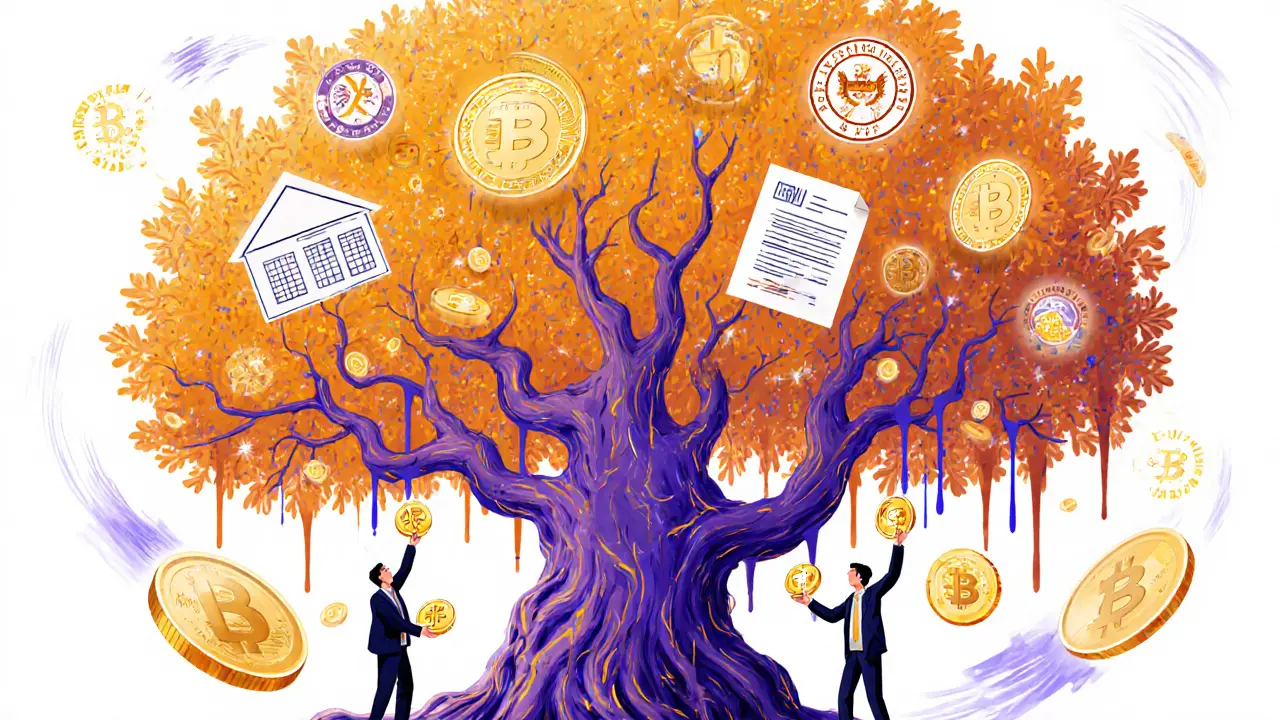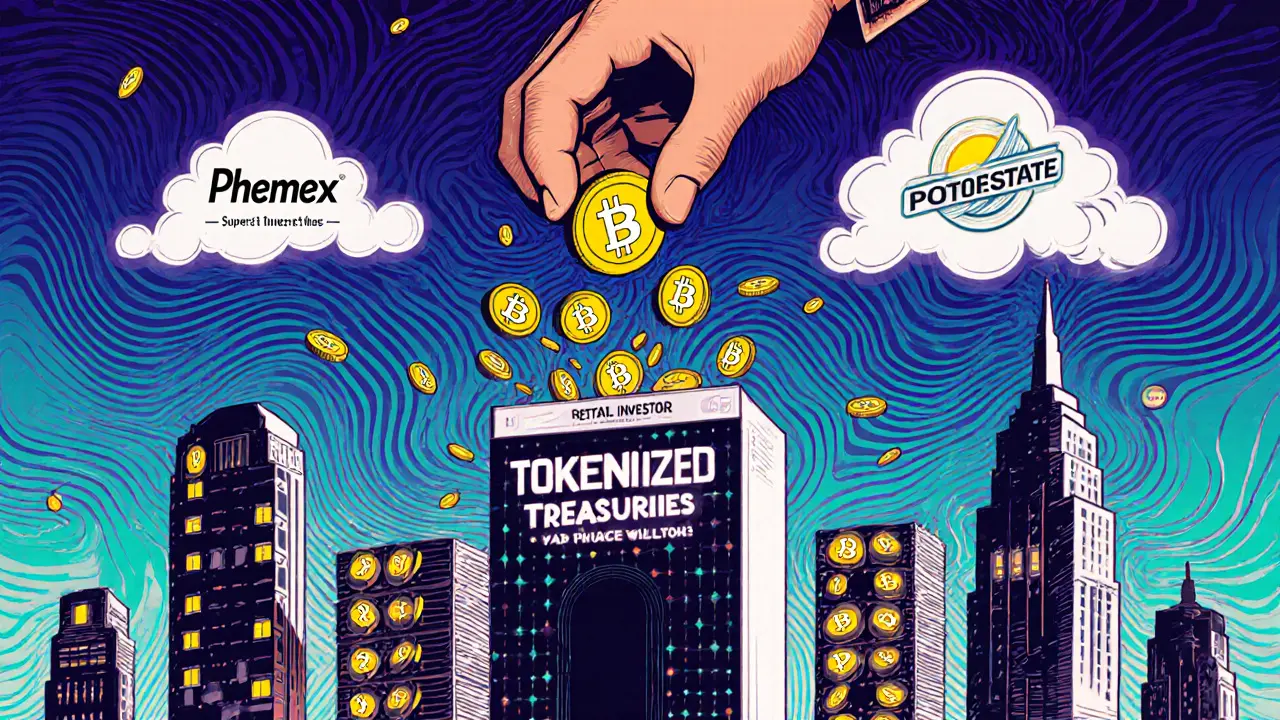RWA Tokenization Market Size: $34.86 Billion and Growing Fast in 2025
RWA Market Growth Estimator
Project RWA Market Growth
Estimate how the RWA tokenization market might grow based on different growth rates and time periods. Current market size: $34.86 billion (October 2025)
The RWA tokenization market hit $34.86 billion in late October 2025 - and it’s not slowing down. Just three months earlier, it was at $24 billion. That’s a 45% jump in under 90 days. This isn’t a speculative bubble. This is real money moving from traditional finance into blockchain-based ownership of physical assets like U.S. Treasuries, private loans, gold, and even apartment buildings. What used to be a niche experiment is now a core part of how institutions manage capital.
What Exactly Is RWA Tokenization?
Real-world asset (RWA) tokenization means turning something tangible - like a bond, a piece of land, or a gold bar - into a digital token on a blockchain. Each token represents a share of ownership. Instead of buying a whole $1 million office building, you can buy a token worth $100 that gives you a tiny slice of it. The blockchain records who owns what, when it was bought, and how it’s transferred - no paper trails, no middlemen, no delays. This isn’t just about making things digital. It’s about fixing broken systems. Traditional asset trading takes days to settle. With tokenization, it happens in minutes. Liquidity is locked up in assets like private credit or commercial real estate. Tokenization unlocks that. And because ownership is broken into tiny pieces, people who couldn’t afford $500,000 in real estate can now invest $50.What’s Driving the Explosion?
Three things are fueling this growth: big players, regulatory clarity, and real demand. BlackRock’s BUIDL initiative alone has tokenized $2.85 billion in U.S. Treasuries. That’s not a side project - it’s a major part of their portfolio. Tether’s XAUT, a gold-backed token, grew 72% in just one month and now sits at $1.6 billion. These aren’t startups. These are trusted names with trillions in assets under management. In the U.S., the GENIUS Act gave legal clarity to tokenized assets. Before, institutions were hesitant. Now, they know the rules. The U.K. and other regions are following suit. That’s huge. Regulation doesn’t kill innovation - it enables it. Demand is real too. Investors want yield. U.S. Treasuries are safe, but they’re not high-return. Tokenized Treasuries offer the same safety with daily liquidity and better yields. Private credit - loans to small businesses - is now the biggest segment at $14.5 billion. It’s yielding 8-12%, and now you can get in with $100 instead of $1 million.Market Breakdown: Where Is the Money?
The RWA market isn’t spread evenly. Most of the value is concentrated in just two areas:- Private Credit: $14.5 billion (58% of the market). These are loans to businesses that banks won’t touch. Tokenization lets investors get exposure without the headaches of managing loans directly.
- U.S. Treasuries: $7.4 billion (34%). BlackRock’s BUIDL dominates here. These are digital versions of government bonds, traded 24/7 with instant settlement.
- Commodities: $3.53 billion. Tether’s XAUT (gold) is the star here. Silver, oil, and even copper are starting to be tokenized.
- Real Estate: $1.2 billion. Projects like DAMAC’s $1 billion tokenized property portfolio show the potential. Imagine owning a share of a Dubai skyscraper from your phone.
- Institutional Funds: $2.97 billion. These are tokenized versions of hedge funds, private equity, and money market funds.

Why Is Growth Accelerating So Fast?
In 2022, the RWA market was under $1 billion. By June 2025, it hit $24 billion. By October? $34.86 billion. That’s not linear growth. It’s exponential. Why? Because the infrastructure is finally working. Custody solutions for tokenized assets are now reliable. Exchanges like Phemex and Superstate are handling institutional-grade trading. Smart contracts automate dividend payments, compliance checks, and transfers. No more manual paperwork. Also, the economic incentive is too strong to ignore. Tokenization cuts settlement risk by 90%. It reduces international transaction costs by 30-50%. It slashes the illiquidity premium on private assets by 15-25%. For institutions managing billions, those savings add up to billions. Retail investors are catching on too. Apps now let you buy $10 worth of tokenized U.S. Treasuries. You don’t need a broker. You don’t need a minimum balance. Just a wallet and an identity check.What Do Experts Predict for 2030?
Forecasting this market is like predicting the internet in 1995. Everyone agrees it’s huge - but no one agrees on how huge. McKinsey says $2-4 trillion by 2030. That’s plausible if regulation stays steady and adoption is gradual. BCG thinks $16 trillion. That assumes tokenization replaces traditional bond and private equity markets - a big leap. Standard Chartered’s $30 trillion by 2034? That’s the moonshot. It means tokenized assets become the primary way the world holds debt, real estate, and commodities. CoinLaw and Antier Solutions land in the middle: $18.9 trillion by 2033. That’s still more than 500 times today’s market. The outlier? Emergen Research, which predicts just $32.4 billion by 2034. That’s almost the same as today’s value. Their model likely excludes major asset classes or assumes slow regulatory progress. Given how fast things are moving now, that seems unlikely. Bottom line: even the most conservative estimates show a market 10x larger than today. The real question isn’t if it will grow - it’s how fast.
What’s Holding It Back?
Despite the momentum, challenges remain. Regulatory fragmentation is the biggest. The U.S. is moving fast. The EU’s MiCA framework is still being rolled out. Asia has no unified approach. That creates uncertainty for global investors. Custody is another hurdle. Who holds the keys to a tokenized building? A bank? A crypto exchange? A specialized custodian? The industry is still figuring out the best models. Interoperability matters too. Can a tokenized bond on Ethereum be traded on a Solana-based marketplace? Not yet. Without cross-chain compatibility, liquidity stays trapped. And let’s not forget fraud. Bad actors still try to tokenize fake assets. That’s why compliance is critical. Every issuer needs KYC, AML, and legal structure verification - and that’s expensive. But these aren’t dead ends. They’re growing pains. Solutions are already being built. And every time a major institution like BlackRock or J.P. Morgan enters, trust increases.What’s Next?
The next 12 months will be decisive. More banks will launch tokenized money market funds. More sovereigns may experiment with digital bonds. Real estate platforms will scale. Carbon credits could finally gain traction if regulations align. Retail access will explode. Apps like Superstate and Anemoy are already letting everyday people invest in tokenized assets. In two years, your retirement app might offer tokenized Treasuries alongside ETFs. The real winner? Efficiency. The financial system is slow, expensive, and opaque. RWA tokenization fixes all three. It’s not replacing finance - it’s upgrading it. If you’re watching this market, don’t look at the price of Bitcoin. Look at the number of issuers. There are now 227 active issuers and nearly half a million asset holders. That’s not speculation. That’s adoption. The RWA tokenization market isn’t the future. It’s here. And it’s growing faster than anyone expected.What is the current size of the RWA tokenization market?
As of October 24, 2025, the RWA tokenization market is valued at $34.86 billion, according to data from RWA.xyz reported by Phemex. This reflects rapid growth from $24 billion in June 2025, with private credit and U.S. Treasuries making up the majority of the value.
Which assets make up the largest portions of the RWA market?
Private credit leads at $14.5 billion (58%), followed by U.S. Treasuries at $7.4 billion (34%). Commodities like gold-backed tokens (e.g., Tether’s XAUT) total $3.53 billion, and real estate tokenization stands at $1.2 billion. These four categories account for over 95% of the current market.
Who are the major players in RWA tokenization?
BlackRock’s BUIDL initiative is the largest single player, with $2.85 billion in tokenized U.S. Treasuries. Tether dominates the commodities space with its $1.6 billion XAUT gold token. Other key players include Securitize, Tokeny, Superstate, and Anemoy, which provide infrastructure, issuance, and trading platforms for institutional and retail investors.
Why is the RWA market growing so fast in 2025?
The growth is driven by regulatory clarity (like the U.S. GENIUS Act), institutional adoption (BlackRock, J.P. Morgan), improved infrastructure (custody, exchanges), and strong investor demand for yield and liquidity. Tokenization reduces settlement times from days to minutes, cuts transaction costs by 30-50%, and enables fractional ownership - making previously inaccessible assets available to small investors.
What’s the projected market size by 2030?
Projections vary widely. McKinsey estimates $2-4 trillion, BCG predicts $16 trillion, and Standard Chartered forecasts up to $30 trillion by 2034. Most analysts agree the market will reach at least $10 trillion by 2030, driven by tokenization of bonds, real estate, and private credit. Even conservative estimates show a 300x increase from today’s levels.
Can regular people invest in RWA tokenization?
Yes. Platforms like Superstate and Anemoy now allow retail investors to buy fractional shares of tokenized U.S. Treasuries for as little as $10. While some assets still require accredited investor status, the trend is toward broader access. Compliance is handled automatically through smart contracts and identity verification systems.
Eric Redman
November 1, 2025 AT 05:03Brett Benton
November 1, 2025 AT 06:50David Roberts
November 2, 2025 AT 18:35Monty Tran
November 4, 2025 AT 18:32Shaunn Graves
November 6, 2025 AT 04:59Kaela Coren
November 6, 2025 AT 11:35Nabil ben Salah Nasri
November 7, 2025 AT 00:12alvin Bachtiar
November 8, 2025 AT 23:59Josh Serum
November 10, 2025 AT 21:46DeeDee Kallam
November 12, 2025 AT 04:55Helen Hardman
November 14, 2025 AT 04:27Bhavna Suri
November 14, 2025 AT 09:47Elizabeth Melendez
November 16, 2025 AT 08:44Phil Higgins
November 16, 2025 AT 21:28Ron Cassel
November 17, 2025 AT 09:21Wesley Grimm
November 19, 2025 AT 06:22mark Hayes
November 20, 2025 AT 03:17Derek Hardman
November 21, 2025 AT 01:36Eliane Karp Toledo
November 21, 2025 AT 15:40